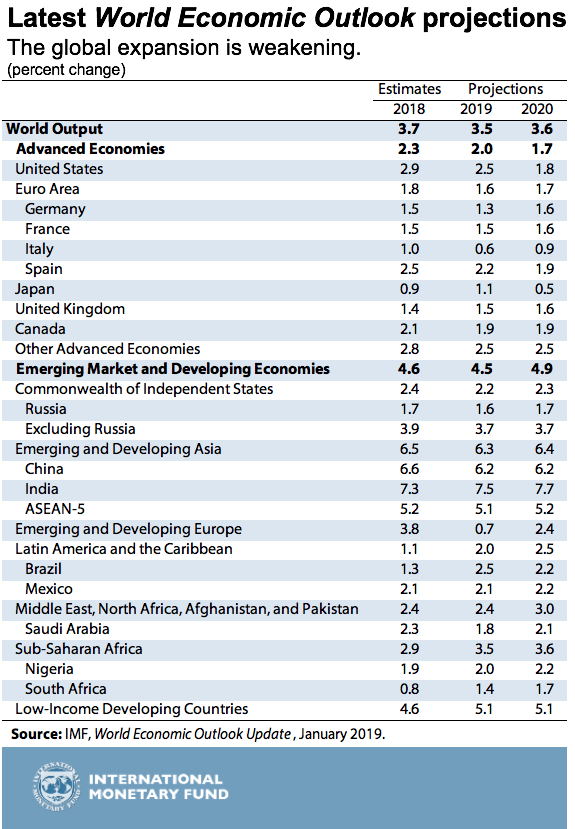While global growth in 2018 remained close to postcrisis highs, the global expansion is weakening and at a rate that is somewhat faster than expected. This update of the World Economic Outlook (WEO) projects global growth at 3.5 percent in 2019 and 3.6 percent in 2020, 0.2 and 0.1 percentage point below last October’s projections.
The downward revisions are modest; however, we believe the risks to more significant downward corrections are rising. While financial markets in advanced economies appeared to be decoupled from trade tensions for much of 2018, the two have become intertwined more recently, tightening financial conditions and escalating the risks to global growth.
The global expansion is weakening and at a rate that is somewhat faster than expected.
We have revised downwards our forecasts for advanced economies slightly, mainly due to downward revisions for the euro area. Within the euro area the significant revisions are for Germany, where production difficulties in the auto sector and lower external demand will weigh on growth in 2019, and for Italy where sovereign and financial risks—and the connections between them—are adding headwinds to growth.
The US expansion continues, but the forecast remains for a deceleration with the unwinding of fiscal stimulus. Across advanced economies, we foresee growth to slow from 2.3 percent in 2018 to 2 percent in 2019 and 1.7 percent in 2020. This softening growth momentum has provided little lift to inflation. While core inflation is close to target in the United States where growth is above trend, it remains significantly below target in the euro area and Japan.
Economic activity in emerging and developing economies is also projected to tick down to 4.5 percent in 2019, with a rebound to 4.9 percent in 2020. The projection for 2019 has been lowered (0.2 percentage point) from October mainly because of a large projected contraction in Turkey, amid policy tightening and adjustment to more restrictive external financing conditions. There is also a significant downgrade to growth in Mexico in 2019–20, reflecting lower private investment. The projected rebound in 2020 is due to an expected recovery in Argentina and Turkey.
The outlook for emerging markets and developing economies reflects the continued headwinds from weaker capital flows following higher US policy rates and exchange rate depreciations, even though they have become less extreme. Across emerging economies, some of the pickup in inflation reversed towards the end of 2018.
Overall, the cyclical forces that propelled broad-based global growth since the second half of 2017 may be weakening somewhat faster than we expected in October. Trade and investment have slowed, industrial production outside the United States has decelerated, and purchasing managers’ indices have weakened, flagging softening momentum. While this does not mean we are staring at a major downturn—it is important to take stock of the many rising risks.
An escalation of trade tensions and a worsening of financial conditions are key sources of risk to the outlook. Higher trade uncertainty will further dampen investment and disrupt global supply chains. A more serious tightening of financial conditions is particularly costly given the high levels of private and public sector debt in countries.
China’s growth slowdown could be faster than expected especially if trade tensions continue, and this can trigger abrupt sell-offs in financial and commodity markets as was the case in 2015–16. In Europe the Brexit cliffhanger continues, and the costly spillovers between sovereign and financial risk in Italy remain a threat. In the United States a protracted US federal government shutdown poses downside risks.
Policy priorities
Given this backdrop policymakers need to act now to reverse headwinds to growth and prepare for the next downturn.
The main policy priority is for countries to resolve cooperatively and quickly their trade disagreements and the resulting policy uncertainty, rather than raising harmful barriers further and destabilizing an already slowing global economy. The call of Group of Twenty leaders to reform the World Trade Organization in Buenos Aires must be accomplished. Where fiscal space is low, fiscal policy needs to adjust in a growth-friendly manner to ensure public debt is on a sustainable path, while protecting the most vulnerable.
Monetary policy in advanced economies should continue to normalize carefully. The major central banks are keenly aware of the slowing momentum—and we expect they will calibrate their next steps in line with these developments. Macroprudential tools should be used where financial vulnerabilities are building up. Across all economies, measures to boost potential output growth and enhance inclusiveness are imperatives.
Lastly, given that policy space for countries is more limited than in 2008, multilateral cooperation will be even more important in the event of a sharper decline in global growth, and it is essential that multilateral institutions like the IMF have adequate resources to deal with the rising risks.





